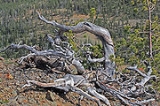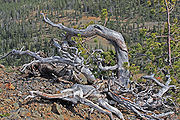
Krummholz
Encyclopedia


German language
German is a West Germanic language, related to and classified alongside English and Dutch. With an estimated 90 – 98 million native speakers, German is one of the world's major languages and is the most widely-spoken first language in the European Union....
: krumm, "crooked, bent, twisted" and Holz, "wood") — also called Knieholz ("knee timber") — is a particular feature of subarctic
Subarctic
The Subarctic is a region in the Northern Hemisphere immediately south of the true Arctic and covering much of Alaska, Canada, the north of Scandinavia, Siberia, and northern Mongolia...
and subalpine tree line landscapes. Continual exposure to fierce, freezing winds causes vegetation to become stunted and deformed. Under these conditions, trees can only survive where they are sheltered by rock formations or snow
Snow
Snow is a form of precipitation within the Earth's atmosphere in the form of crystalline water ice, consisting of a multitude of snowflakes that fall from clouds. Since snow is composed of small ice particles, it is a granular material. It has an open and therefore soft structure, unless packed by...
cover. As the lower portion of these trees continue to grow, the coverage becomes extremely dense near the ground.
Common trees showing Krumholtz formation include Balsam Fir
Balsam Fir
The balsam fir is a North American fir, native to most of eastern and central Canada and the northeastern United States .-Growth:It is a small to medium-size evergreen tree typically tall, rarely to tall, with a narrow conic crown...
, Red Spruce
Red Spruce
Picea rubens is a species of spruce native to eastern North America, ranging from eastern Quebec to Nova Scotia, and from New England south in the Adirondack Mountains and Appalachians to western North Carolina.-Physical description:...
, Black Spruce
Black Spruce
Picea mariana is a species of spruce native to northern North America, from Newfoundland west to Alaska, and south to northern New York, Minnesota and central British Columbia...
, Subalpine Fir
Subalpine Fir
The Subalpine Fir or Rocky Mountain Fir is a western North American fir, native to the mountains of Yukon, British Columbia and western Alberta in Canada; southeastern Alaska, Washington, Oregon, Idaho, western Montana, Wyoming, Utah, Colorado, New Mexico, Arizona, northeastern Nevada, and the...
, Subalpine Larch
Subalpine Larch
Larix lyallii, the Subalpine Larch, or simply Alpine Larch, is a coniferous tree native to northwestern North America. It lives at very high altitudes in the Rocky Mountains of Idaho, Montana, British Columbia, and Alberta...
, Engelmann Spruce
Engelmann Spruce
Picea engelmannii is a species of spruce native to western North America, from central British Columbia and southwest Alberta, southwest to northern California and southeast to Arizona and New Mexico; there are also two isolated populations in northern Mexico...
, Limber Pine
Limber Pine
The Limber Pine, Pinus flexilis, is a species of pine tree-the family Pinaceae that occurs in the mountains of the Western United States, Mexico, and Canada. It is also called Southwestern White Pine and Rocky Mountain White Pine...
, and Lodgepole Pine
Lodgepole Pine
Lodgepole Pine, Pinus contorta, also known as Shore Pine, is a common tree in western North America. Like all pines, it is evergreen.-Subspecies:...
. Instances of the Krumholtz form of Black Spruce, Picea mariana, are found in the northern Canadian Boreal forests. Krumholtz-form Black Spruce and Balsam Fir are abundant in the Alpine Transition Zone of the White Mountains
White Mountains (New Hampshire)
The White Mountains are a mountain range covering about a quarter of the state of New Hampshire and a small portion of western Maine in the United States. Part of the Appalachian Mountains, they are considered the most rugged mountains in New England...
of New Hampshire.
William Rogers Fisher introduced the English terms elfin-tree and elfin-wood to correspond to the German Krummholz in his 1903 translation of Andreas Franz Wilhelm Schimper
Andreas Franz Wilhelm Schimper
Andreas Franz Wilhelm Schimper was a botanist and phytogeographer who made major contributions in the fields of histology, ecology and plant geography.-Biography:...
's Plant-geography upon a Physiological Basis (1898).
Flag tree
A variation of this formation is a flag tree or banner tree. The almost constant, strong winds kill and / or deform branches on the windward side, giving the tree a characteristic flag-like appearance. Where the lower portion of the tree is protected by snow cover, or rocks, only the exposed upper portion may have this appearance. This is a rather common occurrence in Red Spruce trees of the highest peaks of the central, even southern Appalachian MountainsAppalachian Mountains
The Appalachian Mountains #Whether the stressed vowel is or ,#Whether the "ch" is pronounced as a fricative or an affricate , and#Whether the final vowel is the monophthong or the diphthong .), often called the Appalachians, are a system of mountains in eastern North America. The Appalachians...
, and is most commonly seen in the wind swept high peaks and plateaus of the Allegheny Mountains
Allegheny Mountains
The Allegheny Mountain Range , also spelled Alleghany, Allegany and, informally, the Alleghenies, is part of the vast Appalachian Mountain Range of the eastern United States and Canada...
. This formation most notably occurs with high frequency in the Dolly Sods and Roaring Plains West Wilderness
Roaring Plains West Wilderness
The Roaring Plains West Wilderness is a U.S. Wilderness Area in the Allegheny Mountains of eastern West Virginia, USA. It is part of the Monongahela National Forest and includes Mount Porte Crayon, the sixth highest point in the state....
areas along the Allegheny Front
Allegheny Front
The Allegheny Front is the major southeast- or east-facing escarpment in the Allegheny Mountains in southern Pennsylvania, western Maryland, and eastern West Virginia, USA. The Allegheny Front delineates the Ridge-and-Valley Appalachians to its east from the Appalachian Plateau to its west...
in eastern West Virginia
West Virginia
West Virginia is a state in the Appalachian and Southeastern regions of the United States, bordered by Virginia to the southeast, Kentucky to the southwest, Ohio to the northwest, Pennsylvania to the northeast and Maryland to the east...
, typically occurring at elevations of 3,800 feet (1,100 m) and higher. Trade wind
Trade wind
The trade winds are the prevailing pattern of easterly surface winds found in the tropics, within the lower portion of the Earth's atmosphere, in the lower section of the troposphere near the Earth's equator...
s in tropical regions near the equator can also deform trees in a similar manner.

